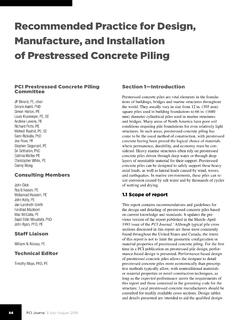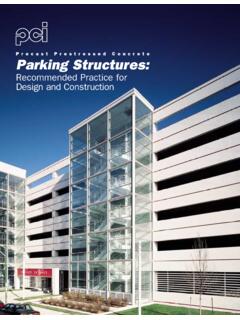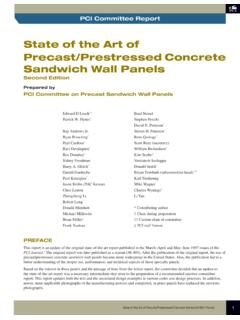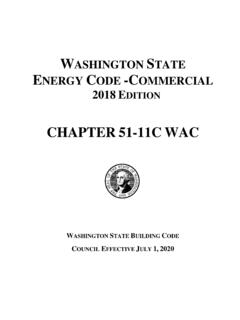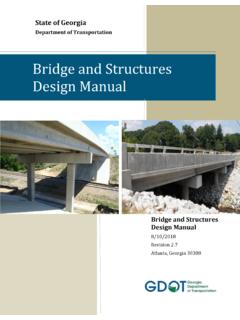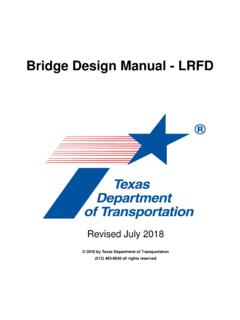Transcription of PCI Bridge Design Manual - 3rd Edition, First Release ...
1 Bridge Design Manual . 3rd Edition, First Release , November 2011. MNL-133-11. 1st Edition, First Printing, 1997. 2nd Edition, First Printing, 2003. PCI Bridge Design MANUAL_____ CHAPTER 6. PRELIMINARY Design . Table of Contents NOTATION ..6 - 3. SCOPE ..6 - 5. PRELIMINARY PLAN ..6 - 5. General ..6 - 5. - 5. Factors for Consideration ..6 - 5. General ..6 - 5. Site ..6 - 5. Structure ..6 - 5. Hydraulics ..6 - 6. Construction ..6 - 6. Utilities ..6 - 6. Required Details ..6 - 7. SUPERSTRUCTURE .. 6 - 10. Beam Layout .. 6 - 10. Jointless Bridges .. 6 - 10. SUBSTRUCTURES.
2 6 - 10. Piers .. 6 - 10. Open Pile 6 - 10. Encased Pile Bents .. 6 - 10. Hammerhead Piers .. 6 - 10. Multi-Column Bents .. 6 - 12. Wall Piers .. 6 - 12. Segmental Precast Piers .. 6 - 12. 6 - 12. Hydraulics .. 6 - 13. Safety .. 6 - 13. Aesthetics .. 6 - 13. 6 - 13. PRELIMINARY MEMBER SELECTION .. 6 - 13. Product Types .. 6 - 13. Design Criteria .. 6 - 14. Live Loads .. 6 - 15. Dead Loads .. 6 - 15. Composite deck .. 6 - 16. concrete Strength and Allowable Stresses .. 6 - 16. Strands and Spacing .. 6 - 17. Design Limits .. 6 - 17. High Strength concrete .. 6 - 17. 6-1 (Nov 11).
3 PCI Bridge Design MANUAL_____ CHAPTER 6. PRELIMINARY Design . Table of Contents Attainable Strengths .. 6 - 17. Limiting Stresses .. 6 - 17. DESCRIPTION OF Design CHARTS .. 6 - 18. Product 6 - 18. Maximum Spans Versus Spacings .. 6 - 18. Number of Strands .. 6 - 18. 6 - 18. PRELIMINARY Design EXAMPLES .. 6 - 19. Preliminary Design Example No. 1 .. 6 - 19. Preliminary Design Example No. 2 .. 6 - 19. REFERENCES .. 6 - 20. PRELIMINARY Design CHARTS .. 6 - 21. PRELIMINARY Design DATA .. 6 - 39. 6-2 (Nov 11). PCI Bridge Design MANUAL_____CHAPTER 6. PRELIMINARY Design . Product Types For precast abutment walls, full capacity may be accomplished by means of field welding of connecting steel plates, followed by corrosion protection of exposed steel.
4 Location of the abutments is a function of the profile grade of the Bridge , the minimum vertical and horizontal clearances required, and the type and rate of end slope. Hydraulics Pier shapes that streamline flow and reduce scour are recommended. Consideration is based on the anticipated depth of scour at the Bridge piers. Measures to protect the piers from scour activity (for example, riprap and pier alignment to stream flow) are recommended. For bridges over navigable channels, piers adjacent to the channel may require pier protection as determined by the Coast Guard.
5 The requirement is based on the horizontal clearance provided for the navigation channel and the type of navigation traffic using the channel. In many cases, piers in navigable waterways should be designed to resist vessel impact in accordance with AASHTO requirements. Safety Due to safety concerns, fixed objects should be placed as far from the edge of the roadway as economically feasible, maintaining minimum horizontal clearances to Bridge piers and retaining walls. Redundant supporting elements minimize the risk of catastrophic collapse. A typical guideline would recommend a minimum of two columns for roadways from 30 to 40 ft wide and three columns for roadways 40 to 60 ft wide.
6 Also recommended is collision protection or Design for collision loads in accordance with LRFD Specifications on piers with one or two columns. Aesthetics The principal direction of view of the piers should be considered when determining their size, shape, and spacing. The piers should be correctly sized to handle the structural loads required by the Design and shaped to enhance the aesthetics of the overall structure. Column spacing should not be so small as to create the appearance of a forest of columns. Chapter 5 discusses aesthetics in greater detail. FOUNDATIONS.
7 Typical foundation types include: Spread footings Drilled shafts Steel pipe piles Prestressed concrete piles Steel H-piles Timber piles Round or square columns of multi-column bents, usually rest on single drilled shafts or on footings that cap multiple piles. Single columns usually rest on footings that cap multiple piles or drilled shafts. Prestressed concrete piles are used extensively in the coastal regions, as well as other locations. For short bents on stream crossings, a line of piles may be extended into the cap, forming a trestle pile bent. These are economically competitive even when the soil is suitable for drilled shafts.
8 Prestressed piles can double as foundations and piers, thus reducing the amount of on-site forming and concreting. Precast, prestressed concrete piles come in different sizes and shapes, ranging from 10 x piles to hollow cylinder piles. PRELIMINARY MEMBER SELECTION. Product Types The preliminary Design charts in Section are based on a blend of national and regional products. Data used to generate the Design charts and basic information resulting from computer runs is provided in tables in Section 6 - 13 (Nov 11). PCI Bridge Design MANUAL_____ CHAPTER 6. PRELIMINARY Design .
9 Product Design Criteria Traditional sections such as rectangular box beams, AASHTO I-beams and AASHTO-PCI Bulb-Tee sections are included because these are still commonly used for bridges with a wide range of configurations. Several other beam types are also included because they represent innovative Design approaches and newer concepts gaining more widespread use. These include a non-composite deck bulb-tee family of shapes, various composite U-beams and a variation on traditional double-tee stemmed beams known as the NEXT beam. The Design charts are not an exhaustive summary of available products since many regional standards exist beyond those presented herein.
10 There are dozens of additional beam types that have not been covered, yet are used successfully by individual states or regionally. States such as Washington, Utah, Texas, Nebraska, Florida, Pennsylvania, the New England states, and others have all produced many variations on traditional I-beams, wide-flange concrete beams, multi-web stemmed beams, solid and hollow plank sections, and others. Many of the states have Design charts similar to those presented in this chapter indicating the span capability of local products. As with most Design and construction decisions, knowledge of the local marketplace is important in determining the optimal configuration for a Bridge .



